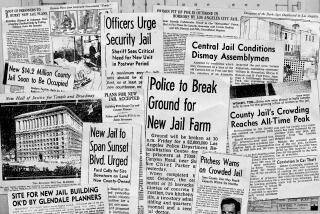Highest-Risk Prisoners Are Moved From San Quentin
- Share via
SAN QUENTIN — San Quentin Prison, for more than a century one of the toughest places in the nation to do time, has been emptied of virtually all its most hardened criminals.
About 1,750 of them, more than half the population of the 137-year-old fortress that once held Charles Manson and Sirhan Sirhan, have been sent to new prisons throughout California as part of a $5-billion prison expansion.
In their place are minimum- and medium-security prisoners, including many who live in trailers outside the prison walls on San Quentin’s fenced-in grounds and who have little contact with higher-risk inmates inside.
California’s Death Row remains here for the 252 prisoners, all men, facing execution by cyanide gas. But aside from them, “we have lost almost all of our hard-core” inmates, said prison spokesman Cal White.
“That once housed the most desperate people in California,” he said, pointing to an empty, five-tier cellblock. “Now, it’s just a temporary holding facility.”
Image of Toughness
The concrete-and-steel compound ringed by guard towers on the edge of San Francisco Bay has long been depicted as one of America’s toughest prisons.
Its inmates included Sirhan, who assassinated Robert F. Kennedy in 1968, and Caryl Chessman, convicted of Los Angeles’ “red light bandit” sex attacks of 1948. He became a best-selling author behind bars before being executed in 1960.
But in the last two years, most of the highest-risk prisoners have been sent to three new prisons. Manson, the leader of a murderous cult and perhaps the most notorious prisoner in California, went to the new Corcoran prison near Fresno.
Corcoran is one of eight prisons opened in California since 1980. The state’s prison population has tripled since then to more than 75,000, more than any other state. None of the older prisons has been affected more than San Quentin.
On the outside, the complex appears as forbidding as ever.
On the inside, what authorities call San Quentin’s “change in mission” is quickly apparent. In addition to holding medium- and minimum-security inmates, it serves as a reception center, where new inmates are sent for orientation and classification.
Extensive Remodeling
The prison has been extensively remodeled, including a $28-million overhaul of an old cellblock. In the hospital, 55 years old but newly refurbished, is the dental ward, a spic-and-span suite that smells powerfully of disinfectant.
Despite the changes, a visitor never forgets that San Quentin is steeped in violence.
Before visitors go through the massive steel gates, a guard warns of the possibility of being taken hostage and adds that state policy “is to never negotiate a prisoner’s freedom for the release of hostages.”
More to Read
Sign up for Essential California
The most important California stories and recommendations in your inbox every morning.
You may occasionally receive promotional content from the Los Angeles Times.










